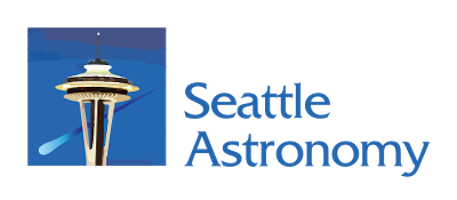In an age when automated programs are scanning the night sky using high-tech telescopes, CCD cameras, and computing power to find near-Earth objects,
Don Machholz continues to search for comets the old-fashioned way.
 |
Seattle Astronomy’s Greg Scheiderer, left, with comet hunter
Don Machholz at the Seattle Astronomical Society’s annual
banquet. Photo: Greg Scheiderer. |
“I do it visually,” Machholz explained at the annual banquet of the Seattle Astronomical Society last month. “I do not use cameras, I do not use CCDs. I look through the eyepiece and I push the telescope.”
Machholz is the record holder, with eleven comets discovered visually since he started his hunt in the mid-1970s. That doesn’t sound like so many, but consider this: according to the
Catalog of Comet Discoveries, there have been 1,502 comets discovered since 2005. Of those, just three have been discovered visually. The Panoramic Survey Telescope & Rapid Response System (
Pan-STARRS) got full or shared credit for thirty-three comet discoveries last year alone. The last time a comet was discovered visually was in 2010, when there were two, and Machholz bagged one of those.
There’s a little bit of luck involved in comet hunting. Machholz jokes that the first thing you need to do to find a comet is to be looking where it is in the 40,000 square degrees of sky. But he has a system. He checks websites to figure out where the programs like Pan-STARRS are looking on a particular night and then conducts his hunt in a different part of the sky. Machholz divides the sky into sections, and makes telescope sweeps covering about fifteen degrees at a time. Then moves down about a half field of view and sweeps again. He keeps meticulous records of his searches.
“It sounds boring, but you get to see a different part of the sky all the time,” Machholz said.
He got interested in astronomy as a boy. His father was a naval navigator and had a book with star charts that Don used to learn the sky. When he was about eight years old his sister brought home a book about meteors that piqued his interest. Finally, Machholz received a telescope for his thirteenth birthday. On the third night out he found Saturn.
“I could see the rings on it,” he recalled, thinking stargazing might not be such a bad hobby. He was hooked.
A family tragedy helped drive Machholz’s comet-hunting program early on. In 1976 his brother, an avid skier, was killed in an avalanche. Machholz found himself depressed, with insomnia, sleeping just a few hours a night, but with lots of energy.
“That’s kind of the ideal ingredients for a comet hunter,” he said. “For the next three or four years my comet hunting program developed to a greater and greater depth. Comet hunting wasn’t just something I did, it became part of who I am.”
His early comet hunting was done from his parents’ back yard and other locations around Concord, California. After moving to San Jose in 1976 he did much of his observing from nearby Loma Prieta mountain. In 1990 he moved to Colfax, California and built an observatory there.
After so much time at the eyepiece, Machholz says his heart still skips a beat or two when he thinks he has found a new comet.
“It’s a very important moment,” he said. “First I want to remember what song was on the radio.” He always has the radio playing when he hunts, and his presentation was full of music from the Rolling Stones and the Beatles to Phil Collins and Cyndi Lauper. He adds, though, that there’s no time for jumping up and down when he finds a comet, because there’s serious work to do.
“You don’t want to lose it,” he explained. “You might have it in the field now, but if you bump the telescope or let too much time go by and it drifts out of the field, you have to be able to find it again.”
“You have to be sure you know where you’re looking, make sure it’s not a galaxy or a cluster,” he added. He double checks with his star atlas, makes a drawing that puts the comet in its position compared to the field of stars, and watches to see if it moves. If all that checks out he reports the discovery by email, phone, and fax.
 |
Comet 96/P Machholz as seen by the
HI-2 camera on the STEREO-A spacecraft.
|
Of all of his discoveries, Machholz said comet is 96P/Machholz is his favorite.
“It is an amazing comet; it has its own
Facebook page,” he said.
The orbit of 96/P Machholz changes because of the influence of Jupiter, and the perturbations have some scientists thinking there may be large undiscovered planets way out beyond Pluto. The comet also is low on carbon and cyanogen. This hasn’t been explained, though the leading ideas are that it may have originated in another solar system, or been exposed to temperature extremes that changed its chemical composition.
It was a pleasure to spend an evening with Don Machholz. His lively presentation was full of humor and had the banquet audience laughing and engaged.




